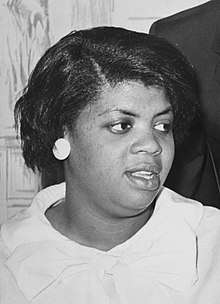Linda Carol Brown
Linda Carol Brown (February 20, 1943 – March 25, 2018) was a campaigner for equality in education. As a schoolgirl in 1954, Brown became the center of the landmark 1951 United States civil rights case Brown v. Board of Education.[1][2] Brown was in third grade at the time, and sought to enroll at Sumner School in Topeka, Kansas. Her admission was denied based on her race.[2] Her lawsuit against segregation in elementary schools was ultimately successful and the resulting Supreme Court precedent overturned the 'separate but equal' doctrine which had been previously established in Plessy v. Ferguson. Brown became an educator and civil rights advocate.
Linda Carol Brown | |
|---|---|
 Linda Brown in 1964 | |
| Born | February 20, 1943 |
| Died | March 25, 2018 (aged 75) Topeka, Kansas |
| Nationality | American |
| Other names | Linda Carol Smith Linda Carol Thompson |
| Known for | Brown v. Board of Education |
Early life and education
Linda Brown was born in Topeka, Kansas, on February 20, 1943. She was the oldest of three daughters of Leola and Oliver Brown.[3] Oliver Brown was a welder and pastor.[4][5] At the direction of the NAACP, Linda Brown's parents attempted to enroll her in nearby Sumner elementary school and were denied.[6][3][7][8] This allowed Brown's family to join the group of civil rights lawsuits coordinated and supported by the NAACP, which would ultimately be decided in the US Supreme Court case Brown v. Board of Education.[3][6] The Browns' name was alphabetically first among the families suing the Topeka Board of Education which is why their name was listed first and the case is commonly referred to as Brown vs. the Board of Education. Although her right to attend a non-segregated school was ultimately upheld by the Supreme Court, Brown did not have the opportunity to attend Sumner.[6] By the time the case was decided in 1954, Brown was in junior high school.[3] Brown was reportedly harassed by journalists after the ruling.[2] Brown later attended Washburn and Kansas State University.[3]
Involvement in Brown v. Board of Education
At the time of the Brown v. Board of Education case, accommodations for black students in public schools were substandard. Many black children were educated in schools that lacked basic amenities like running water or proper classrooms. As long as black schools and white schools offered the same accommodations, schools could remain segregated under the 1896 Plessy v. Ferguson decision.
In order to force the government to rectify the resource disparities between schools, the NAACP litigated cases around the country in hopes that one case would eventually make it to the Supreme Court. In Topeka, the NAACP found 13 families willing to enroll their children in non segregated schools. Although Linda Brown attended segregated Monroe Elementary, which was more than a mile away from her home, Sumner Elementary was six blocks from her house. After her parents were denied admission to Sumner, they were able to join the NAACP's class action suit.
Despite the fact that Sumner was a few blocks from their home, the Browns did not actually want to send their child to Sumner. In fact, Brown's mother attended Monroe and she loved the teachers and environment at Monroe. At the time, talented, college educated blacks could not easily enter many fields because of racial barriers. Many of them turned to teaching in predominantly black schools. Because of the calibre of teachers at Monroe, the Browns were very pleased with the school. Ultimately they changed their minds because in principle, if they did not like Monroe, they wanted to have the option to send Linda to Sumner.[9]
Career and Family
Throughout her life, Brown continued her advocacy for equal access to education in Kansas.[3] Brown worked as a Head Start teacher and a program associate in the Brown Foundation.[2] She was a public speaker[7] and an education consultant.[5][3][6] She divorced her first husband,[3] Charles D. Smith.[2][5] Her second husband, Leonard Buckner, died.[3][5] Her third husband was William Thompson,[3][5] who also preceded her in death.[6] She had two children, Charles and Kimberley, from her first marriage.[5] She is also survived by her grandsons, C. Andrew Smith III, Donnell Smith, and Lawrence Smith.
In 1979, with her own children attending Topeka schools,[6] Brown reopened her case against the Kansas Board of Education, arguing that segregation continued.[3][2] The appeals court ruled in her favor in 1993.[3]
Legacy
In addition to her lifelong advocacy in law and education, Linda Brown's legacy includes the declaration of historic landmark status for both Sumner, the nearby whites-only school she sought to attend alongside her neighbors, and Monroe, a more distant, segregated elementary school. She is a symbol of the African-American legacy.[4] In 1992, Monroe was declared a national historic site.[4]
References
- "Linda Brown obituary | Register". The Times. Retrieved April 11, 2018.
- Smith, Harrison; Silverman, Ellie. "Linda Brown Thompson, girl at center of Brown v. Board of Education case, dies". The Washington Post. Retrieved April 25, 2018.
- "Linda Brown Biography". Biography.com. Retrieved April 25, 2018.
- Grinberg, Emanuella; Jones, Sheena; Vera, Amir. "Linda Brown, woman at center of Brown v. Board case, dies". CNN. Retrieved April 25, 2018.
- Carlson, Michael. "Linda Brown obituary". The Guardian. Retrieved April 25, 2018.
- Romo, Vanessa. "Linda Brown, Who Was At Center Of Brown v. Board Of Education, Dies". NPR. Retrieved April 25, 2018.
- James, Mike. "Linda Brown of Brown v. Board of Education dies; was a symbol of struggle against segregation". USA Today. Retrieved April 25, 2018.
- "Myths vs Truths". Brown Foundation. Retrieved April 25, 2018.
- "MISS BUCHANAN'S PERIOD OF ADJUSTMENT". Revisionist History. Retrieved September 1, 2018.